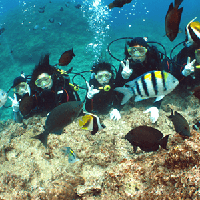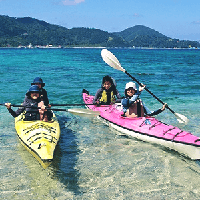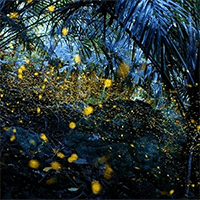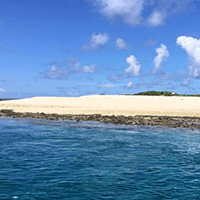List of Ou Island
- Age 6~Age 100
- 3~4 hours
- 09:00 / 14:00
"Ko-Iga" is the highest peak of pottery in history, known as "exceptional beauty" in the world of tea ceremony, mainly during the Sengoku period, when Sen no Rikyu, Oda Nobunaga, and Toyotomi Hideyoshi were active, and the Azuchi-Momoyama period. Experience Awaji Iga making, a reproduction of the Ko-Iga making used in tea ceremony at that time, with one-on-one guidance from a craftsman who hand-made the largest six-tiered climbing kiln in Japan. Ko-Iga is fired at the world's highest firing temperature of 1400℃ for several days, which is unparalleled in the world, so the shape is distorted and sometimes it breaks when firewood is repeatedly hit against it, but the absolute presence and scenery that surpasses this are known as exceptional beauty. (*250℃-450℃ in a bonfire, 1500℃ in a blast furnace) Awaji Iga aims to revive Ko-Iga and values the invisible process and value, so it does not use modern tools such as burners and thermometers, or glazes that glassify the surface. During the Sengoku period, wars were taking place all over Japan, but no one really wanted war, and tea ceremonies served as a place for secret talks to avoid war. It is said that Ko-Iga was used as a special tool to hold a special tea ceremony, which could avoid war if successful, or lead to war if unsuccessful. At Tsurugi Kiln, you can experience the revival of Ko-Iga, which was used in tea ceremonies that determined history and people's lives and deaths, and the making of Awaji Iga pottery. *The actual experience is limited to the forming process. During the four days and nights of the kiln firing in February, you can visit the impressive site at any time. Please visit Awaji Island three times to enjoy the forming process, the kiln firing in February, and the collection after April. ■Itinerary 1. Decide what to make 2. Knead the clay 3. Shape, make strings, hand-form, and make balls *The actual experience is limited to the forming process. During the kiln firing in February, you can see the items you made yourself. *As the items are fired once a year during the kiln firing in February, they will be handed over after spring.
- Age 10~Age 100
- Within 1 hour
You can experience making incense sticks by choosing the scent and shape using rare sandalwood. After molding, dry it at home and light it or enjoy it as a room fragrance. The northern part of Awaji Island, where Parche Fragrance House is located, is known as a town of fragrance because of the concentration of incense manufacturers. You can experience making incense sticks using the rare sandalwood that is unique to the town of fragrance. It is a time to learn about the ingredients of incense, experience the manufacturing process, and learn about incense. Take it home, dry it, light it, and enjoy it as a room fragrance! The experience schedule is as follows. ● Meeting place / reception Fragrance House (please come to the photo) ● Incense making experience (50 minutes) ① Explanation of the experience ② Choose one of four types of fragrance. ③ Put the ingredients in a mortar and knead it with a pestle until it becomes clay-like. ④ Use a stick to stretch it to a uniform thickness. ⑤ Cut it into your desired shape. ⑥Arrange the removed incense sticks on the cardboard, stack the cardboard boxes, secure them with rubber bands, and put them in a bag to take home. ⑥Finished! Once you get home, let the incense dry (for about 2-3 days).
- Age 6~Age 100
- 2~3 hours
- 11:00 / 11:30 / 12:00 / 12:30 / 13:00 / 13:30 / 18:00
Kairi is a renovated old house located in the inland scenery of Awaji Island, where the traditional scenery remains. You can enjoy dishes that are carefully prepared one by one using local ingredients, tableware, and space that the owner is particular about, and the scenery will relax your mind. The owner is particular about using seasonal ingredients that correspond to the seasons of Awaji Island! As much as possible, he uses locally grown and locally harvested ingredients. He takes the time and effort to carefully arrange each dish with delicate care, using crops that have been grown with love and seafood that have been harvested with great effort and hard work. If he cannot get them, he himself goes to pick wild vegetables and makes tea. The owner's attention to detail can be felt not only in the ingredients, but also in the tableware, forks, knives, chopsticks, temperature and space to suit the dishes served. Also, Kairi does not have a set menu. He thinks about the local ingredients that are available at the time, so the menu is handwritten by the owner and posted at the entrance of Kairi every day. Looking out from the entrance, you can see the unspoiled scenery of the past. The interior of this old-fashioned house blends in with the scenery, and you can enjoy a relaxing time in a space that exudes the beauty of traditional Japan, with an irori hearth, a veranda, nostalgic yet beautiful patterned glass windows, and a transom at the top of the room that acts as a partition while letting in air and light.
- Age 0~Age 100
- 1~2 hours
- 09:00 / 10:00 / 11:00 / 13:00 / 14:00 / 15:00 / 16:00
Awaji tiles have been around for 400 years since the Edo period. As one of the three major tile production areas in Japan, tiles are still being manufactured there. The craftsmen who make onigawara and decorative tiles by hand are called "onishi", and it is a valuable experience to be able to see the craftsmanship of the onishi, who know the soil. Awaji tiles have been around for 400 years since the Edo period. As one of the three major tile production areas in Japan, tiles are still being manufactured there. The craftsmen who make onigawara and decorative tiles by hand, which are indispensable for temples and shrines, are called "onishi", and their numbers are decreasing, with only about 10 on the entire island of Awaji (about 50 nationwide). Tatsumi Co., Ltd., which you will visit on this plan, has five onigawara. The factory tour is a private plan limited to one group per time. With the guidance of the potter's president, Okitsu Yusuke, you will observe the tile manufacturing process and the techniques used by the onigawara craftsmen to make the onigawara tiles. You will also be able to talk to the onigawara craftsmen, who will be happy to answer any questions you may have. Afterwards, in the exhibition area, valuable pieces made during the Azuchi-Momoyama period are on display, giving you a glimpse into the evolution of this traditional craft that has continued for 400 years. Another attraction is that all the onigawara craftsmen's works from the Azuchi-Momoyama period to the present day are on display in one place. After the experience, you will be given a souvenir aromatic tile to choose from and can take home with you. Below is the experience schedule. You will be guided through the tour as follows: 1. Manufacturing site 2. Onigawara craftsmen at work 3. Onigawara collection (exhibition area)
- Age 6~Age 100
- Within 1 hour
- 10:00 / 14:00
Awajishima is known for its sweet and soft onions. We will learn the secrets of their deliciousness from Awajishima Hamada Farm, which grows onions in the Mihara Plain, the most prosperous area for onions production, and then we will head out to harvest! You can take home a bag of harvested onions as a souvenir. This is an experience where you can learn about why Awajishima onions are so delicious, and enjoy Awajishima onions even after you return home. Awajishima is a representative onion producing area in Japan. You can experience harvesting on an onion farm. The famous owner of Awajishima Hamada Farm, Tetchan, will teach you the secrets of Awajishima onions' deliciousness, and if you wish, you can even experience biting into an onion. After completing the preliminary preparations, you will finally enter the field and harvest the onions. You can take the harvested onions home as a souvenir. You can enjoy the soft and delicious Awajishima onions even after you return home. Experience Schedule Meet at the Awajishima Hamada Farm parking lot (20 spaces), then guide to the onion field. Explanation of the characteristics of Awajishima onions and harvesting methods (20 minutes). Head to the onion field! Harvest a net full of onions (20 minutes). End on site.
- Age 12~Age 100
- 1~2 hours
- 10:00 / 13:00
Surrounded by nature at the foot of a small hill, Shunyoso shows off the graceful expressions of the four seasons that are unique to Japanese-style architecture. The owner, who is also a certified old house appraiser, will guide you through the house and explain the traditional techniques that are difficult to reproduce today, the design that highlights the playfulness of the craftsmen, and the immeasurable historical and cultural value. After the tour, Shunyoso will quickly transform into a sweets shop. Enjoy an elegant moment with tea and Japanese sweets in an elegant space. Shunyoso is a masterpiece of modern Japanese architecture that was designed in 1941 by architect Toyoen Yamamoto, an authority on the study of home orientation, based on the ideas of feng shui, and was completed over a period of seven years by local carpenter Sankichi Saito and others. Further on, in 1983, the walls, gateposts, doors and gardens were renovated by architect Izue Hiroshi, who was even called a "master" by the famous architect Kurokawa Kisho, and they now harmonize beautifully to create a magnificent architectural landscape. The vast grounds of 1320m2 (approximately 1,400m2) contain eight buildings, including the guest house, storehouse, reception hall, sleeping hall and permanent residence, and in 2004 it was designated as a nationally registered tangible cultural property, and in 2017 it was designated as an important structure for the formation of the Hyogo Prefectural Landscape. However, with the aging of the population and a social trend in recent years that only pursues efficiency, it became difficult for the previous owner to maintain and manage the buildings, and they gradually deteriorated, leading to a long period of time when the gates were closed. The turning point came in 2015. In order to preserve this precious cultural asset for future generations, the fourth-generation owner purchased it and began repairs and renovations. Finally, in October 2016, Shunyo-so was revived and reborn as a new international tourist resource for Awaji Island. In this experience program, the owner himself will guide you through the house, explaining the charms of the house, such as the traditional techniques that are difficult to reproduce today, the building materials that are also difficult to obtain today, the designs that highlight the playfulness of the craftsmen scattered throughout, and the elegant furnishings, based on the historical background of Shunyo-so. Please enjoy this space, which is filled with history and culture and represents the best of traditional techniques, to the fullest. After the tour, you will be served tea and Japanese sweets in the tea room or one of your choice. Please enjoy not only as a precious cultural asset, but also as a sweet shop. *Guides in English are also available, so we can accommodate customers from overseas. *A five-minute walk from Shunyoso is the historic and prestigious "Takenoguchi Hachiman Shrine," which celebrated its 1,100th anniversary in 2021. Why not visit the shrine as well? You can also enjoy a stroll through the historical and atmospheric streets of the Takenoguchi area. Experience schedule (The schedule below starts at 10:00, but please read the time differently if starting at 13:00) 10:00 Meet on site 10:05 Check-in and briefing Guided tour of Shunyoso 11:00 Enjoy tea and Japanese sweets in the teahouse. 11:30 End
- Age 6~Age 100
- 2~3 hours
- 10:00 / 13:00 / 15:00
At Senkoji Temple, which boasts a history of 1100 years and has a temple on the summit of Sakiyama, a sacred mountain on Awaji Island, you can visit the main hall while enjoying the view of Sumoto City, one of the eight scenic views of Sumoto, and experience a sutra copying experience in a mysterious silence, which is an extraordinary experience. If you wish, you can also visit Iwato Shrine after the experience. Sakiyama, also known as Awaji Fuji, is said to be the first mountain created in Japan in the legend of the creation of the world by the gods Izanagi and Izanami. At Senkoji Temple, which has a temple on the summit of Sakiyama, you can experience copying sutras. First, you can climb about 200 steps to tour the grounds of Senkoji Temple, learn about the origins of Senkoji Temple, and see the place where the Awaji Island custom of "Dango Korogashi", which is rare nationwide, is performed at the temple. You will also be greeted by a lion-like boar, instead of a lion-dog, enshrined in front of the main hall. Because it is a temple on the mountaintop, you can see the central and southern part of Awaji Island, and if the weather is good, you can see the Naruto Strait and Wakayama. Return to the temple office and go to the "Daishido" to experience copying sutras. In copying sutras, you will copy the general Heart Sutra. Place the paper on top of the model Heart Sutra and copy it with a brush pen. Beginners are also welcome. By copying the characters in a solemn space, you can spend a valuable time reflecting on yourself. You can donate the copy to the temple or take it home. After the experience, you can also visit "Iwato Shrine", a popular power spot that enshrines a huge rock where Amaterasu Omikami hid herself, about 10 minutes down from the temple. (Please note that this is a full-scale mountain path) Experience schedule (for example, if the tour starts at 13:00) Meet at 13:00 *Walk around the temple grounds, including visiting the main hall (guided by the head priest Okazaki) 14:00 Experience copying sutras at the Daishido (approx. 30 minutes to 1 hour) 15:00 Scheduled end *After the tour, you can walk around the temple grounds and visit Iwato Shrine (on your own). It takes about 10 minutes to walk one way up the mountain path to Iwato Shrine.
- Age 12~Age 100
- 2~3 hours
- 10:00 / 14:00
Naohara Gyokusei is a master of Nanga painting who grew up on Awaji Island. He is also a Rinzai Obaku sect monk, and at Kokusei Zenji Temple, which he rebuilt, you can enjoy a beginner-friendly zazen experience and appreciate Gyokusei's friendly Nanga paintings that he personally painted. After the 60-minute zazen experience, you will listen to the current chief priest explain the Zen teachings contained in Gyokusei's works while drinking tea, then move to Minami Awaji City Takikawa Memorial Museum Gyokuseikan (5-minute walk) and view the diverse works of Naohara Gyokusei that are housed in the museum. This is a special experience that expresses the trinity of Nanga, haiku, and Zen, and allows you to feel the spirit of "kugazenichinyo" and reflect on yourself. Naohara Gyokusei is a master of Nanga painting who has ties to Awaji Island. He was also a painter and haiku poet, and a Rinzai Obaku sect monk, and became the chief priest to rebuild the dilapidated Zen temple Kokusei-an (later Kokusei Zenji) on Awaji Island where he grew up. At Kokusei Zenji Temple, which was magnificently rebuilt by Gyokusei, you will first complete a beginner-friendly zazen experience (about 60 minutes), after which you will listen to the current head priest explain the Zen teachings contained in Gyokusei's works while drinking tea, and then view Gyokusei's intimate works, which are privately painted by Gyokusei and housed in a storehouse within the temple grounds. You will be able to view rare sliding door paintings and other works up close without any partitions. After that, you will move to the Takikawa Memorial Museum of Art Gyokuseikan (about a 5-minute walk, 200m), where many of Gyokusei's paintings are on display, and finally view the masterpieces housed in the museum's collection. You will be able to experience a special time to reexamine yourself through the spirit of "Kuga Zen Ichinyo," which expresses the trinity of Nanga, haiku, and Zen that Naohara Gyokusei loved.
最近チェックしたプラン
Please wait a moment
![[Hyogo, Minami Awaji] Experience making "Awaji Iga", a reproduction of "Ko-Iga", the highest peak of pottery in history, which was known as "exceptional beauty" in the world of tea ceremony mainly during the Sengoku period!の画像](https://img.activityjapan.com/10/58639/10000005863901_1Gz5AIDf_3.webp?version=1744257065)
![[Hyogo/Awaji] No.1 share of domestic incense! Experience making incense while learning about ingredients and manufacturing processes at the incense town theme park. Make your own scent and shape to suit your taste.の画像](https://img.activityjapan.com/10/58590/10000005859001_1Gz5AIDf_3.webp?version=1744001282)
![[Awaji, Hyogo] Heartwarming local cuisine made with ingredients from the sea and mountains of Awaji Island. Enjoy a happy time in the countryside, sitting around the hearth of an old house on the veranda and looking out at the garden and rice terraces.の画像](https://img.activityjapan.com/10/58589/10000005858901_1Gz5AIDf_3.png?version=1744000142)
![[Hyogo, Minami Awaji] 400 years of history! Japan's three major tile production areas: Onigawara craftsmen on Awaji Island: Experience the craftsmanship of Onishi up close and see the manufacturing process! Awaji tile kiln tour experienceの画像](https://img.activityjapan.com/10/58514/10000005851401_1Gz5AIDf_3.webp?version=1743490147)
![[Hyogo, Minami Awaji] The Hamada family will welcome you! Experience harvesting Awaji Island onions while touching the soil and listening to stories about the secrets of their deliciousness and agriculture in a relaxing atmosphere.の画像](https://img.activityjapan.com/10/58509/10000005850901_1Gz5AIDf_3.webp?version=1743489068)
![[Hyogo, Sumoto] <Nationally Registered Tangible Cultural Property> The elegant Japanese-style building "Shunyoso" is imbued with the power of Feng Shui. Immerse yourself in the tasteful and precious historical and cultural space.の画像](https://img.activityjapan.com/10/58456/10000005845601_1Gz5AIDf_3.webp?version=1743128703)
![[Hyogo, Sumoto] Experience something out of the ordinary at Senkoji Temple, located on Sakiyama, which is said to be the first mountain to be created in Japan in the "creation mythology" <copying sutras experience>の画像](https://img.activityjapan.com/10/58443/10000005844301_1Gz5AIDf_3.webp?version=1743129423)
![[Hyogo, Minami Awaji] Experience Zen meditation and appreciating the Nanga paintings of Gyokusei Jikihara at a Zen temple associated with the master of Nanga painting who grew up on Awaji Island.の画像](https://img.activityjapan.com/10/58500/10000005850001_1Gz5AIDf_3.webp?version=1743403386)







